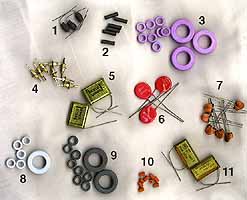
Being a radio amateur, I have always been interested in high frequency signals, such as transients from static electricity and various natural phenomena, radiated and conducted interference, radio interference and interference from various types of high power electronics.
I have attended several courses on the subject, one of them held by Cem-Con AB Elmiljöteknik in Karlskrona, Sweden, a company specialising in curing military interference situations, others held in London and Rotterdam by ICT Training of Swindon, England. After that, I worked with:

BACKGROUND INFORMATION: The picture shows some typical components used for elimination of interference. A description of their functions and use can be found here.
Case Study |
One company was specialising in banknote handling: fast, microcomputer controlled machines, with banknotes swooshing around inside, and containing lots of electric motors and sensors. They had recently changed microprocessor generation, and developed a prototype for a new banknote output machine.
They had problems, because the machine worked only for half a second after power-on, whereupon the processor immediately crashed. It was impossible to run the machine at all.
The machine was neatly made. All cabling was nicely stowed away and strapped together in the available space, along chassis legs etc. The cabling carrying sensor signals, was strapped together with the power cables, and wherever possible, flat cables were used for signal cabling to the microcomputer unit. The company had utilised a special cabling consultant, to get a cabling system as good as ever possible.
Troubleshooting |
Tightly strapped cabling is always wrong. From the very beginning I suspected interference from motors and solenoids jumping over to the signal cabling, disturbing the sensors.
Investigation showed that the sensors were mostly of the fork type, containing an IR light emitting diode and a photo transistor. This type of sensor has a rather high output impedance, and is easily disturbed. The machine was full of various kinds of DC motors, manoeuvering slots and arms. True to their habits, the mechanical engineers had chosen the cheapest possible motors.
Using a fast, digital signal-processing oscilloscope (Tektronix 2430) I found the culprits in this drama.
Results |
Because the company had earlier used older 8-bit processors, some transients on sensor leads and on the data bus had caused no problems.
Now, the number of motors were increased, and a faster processor generation was utilised. Suddenly, spikes on the data bus in the nanosecond realm became important. The interference caused by starting the machine, was enough to make the processor execute illegal instructions, thereby crashing it. The design organisation was not prepared for these effects.
The machine worked.
I recommended the company to retain the digital oscilloscopes I had rented, and channel more money into fast instruments of this type. Furthermore I held courses for the mechanical engineers, to show them that their work was also part of the interference problem.
The Panty Problem |
One of my jobs during my time as phototypesetting repairman was to fix he inexplicable crashes at the Parliament's Printer (Riksdagstrycket). In Sweden, everything uttered in the Parliament must be available in printed form the very next day, so that people may read it. During the 80's a printer in the Parliament took care of this, while the Parliament was temporarily relocated to the House of Culture at Drottninggatan in Stockholm.
The shorthand from the Parliament stenographers was keyed on to magnetic tape at terminals in the printer's office, and was then forwarded to editing and printing. Unfortunately, the editing terminals crashed as soon as someone entered the room, and everything had to be done over again. The Parliament's Printer lost a lot of time on these inexplicable errors, so we service reps had to do something about it.
Our solution was instead to instruct the staff to always bang the magtape (3M tapes with metal backing) in the radiator (which was earthed), before entering a room. This was in the early days of CMOS, when knowledge about EMI was inadequate with set manufacturers.